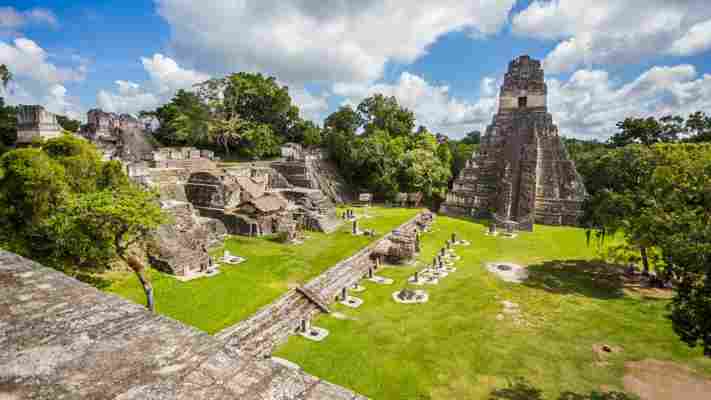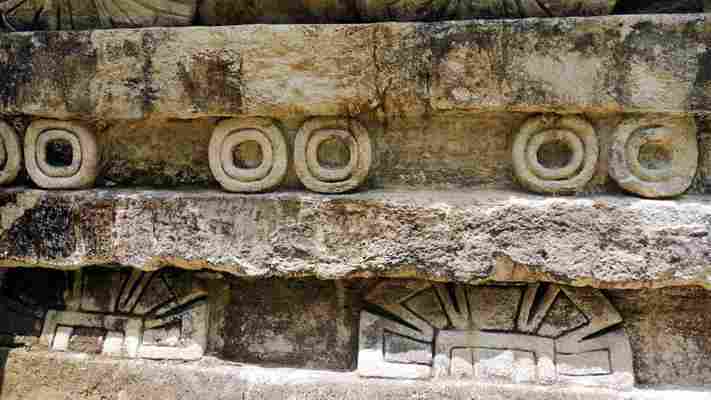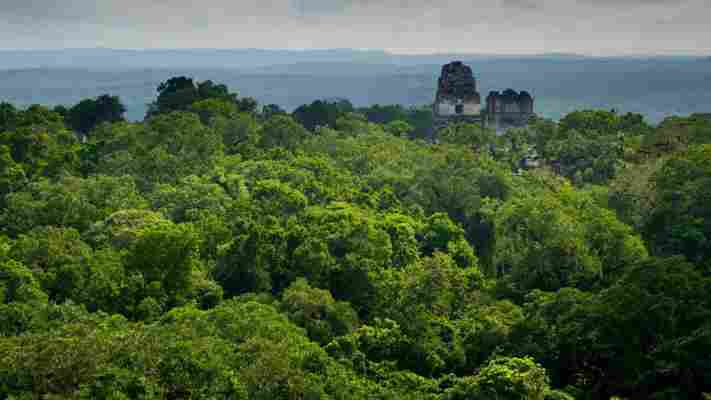Standing in the ancient Mayan city of Tikal in Guatemala, visitors are surrounded by steep limestone pyramids nearly as tall as Notre Dame cathedral while the calls of howler monkeys and toucans emanate from the site's rainforest backdrop. Constructed without the aid of beasts of burden, metal tools or the wheel, these grandiose stoneworks served as the seats of power for the kings and priests who ruled over what was one of the most influential city states in the Maya realm, which spanned Mexico's Yucatan Peninsula, Guatemala, Belize as well as portions of Honduras and El Salvador.

Tikal was an economic and ceremonial hub of a civilisation that, in light of recent laser-based aerial surveys that revealed more than 60,000 structures hidden for centuries by thick jungle, may have once encompassed as many as 10 to 15 million people in total.
In the presence of Tikal's massive stone palaces and temples, each one oriented to attend to the sun's daily transit across the sky, the Maya's prowess as architects and astronomers looms large. But the Maya never would have accurately predicted eclipses and these monuments never would have risen up towards the sky without the mastery of something much more elemental to Mayan survival at Tikal: water.
With no rivers or lakes nearby, the Maya had to create a network of huge reservoirs at Tikal to collect and store enough rainwater during the region's prodigious wet season to last its sizable population – estimates range from 40,000 to as many as 240,000 people at the city's 8th Century peak – through the four- to six-month dry season. These reservoirs facilitated more than 1,000 years of Mayan presence at Tikal, from roughly 600 BC until the site's urban core was finally abandoned by the ruling class around 900 AD.
Last year, archaeologists using modern scientific techniques revealed a new depth to the Maya's hydrological feats. Sediment cores taken from Tikal's reservoirs show that the Maya created the oldest known water filtration system in the western hemisphere.

The Maya left behind an astonishing amount of architecture and artwork (Credit: Samantha Haebich/Getty Images)
The Maya's water purification system was so advanced that one of its key materials, zeolite, is still widely used in water filters today. Zeolites are a type of volcanic mineral made mostly of aluminium, silicon and oxygen that forms when volcanic ash reacts with alkaline groundwater. They come in many forms and have unique physical and chemical properties that allow them to filter out contaminants ranging from heavy metals to tiny microbes . Individual zeolite grains have a porous, cage-like structure, which makes them excellent physical filters, and they are also negatively charged, which means other elements will readily bind to them. This means that when water passes through zeolites, suspended particles can get physically or chemically stuck to the grains of zeolite while the water keeps flowing through the gaps.
You may also be interested in: • The Maya world untouched for centuries • Switerland's gravity-defying solution • Iran's ancient engineering marvel
Though archaeologists only found zeolites in one of Tikal's reservoirs, now referred to as Corriental, shards of clay vessels found there suggest the purified waters of Corriental were used specifically for drinking.
The researchers behind this discovery say the Mayan use of zeolite is the oldest known use of the mineral for water purification in the world, predating its next appearance in a sand filtration system developed by British scientist Robert Bacon in 1627 by roughly 1,800 years. The Maya's zeolite-powered water filtration system, which scholars say looks to have first been constructed around 164 BC, is predated by a cloth filter known as the Hippocratic sleeve that was developed in ancient Greece around 500 BC, but the Maya's method would have been far more effective at removing invisible contaminants such as bacteria or lead.
"I'm Native American and I've always been bothered that archaeologists and anthropologists have traditionally assumed that the Indigenous people of the Americas did not develop the technological muscle that was found elsewhere in the ancient world in places like Greece, Egypt, India or China," said Kenneth Tankersley, an archaeological geologist at the University of Cincinnati and lead author of the study documenting the Maya's use of zeolite. "This system provided the Maya with safe drinking water for more than 1,000 years and other filtration systems known from that era were primitive by comparison – the early Greek filtration method was just bags of cloth."
I've always been bothered that archaeologists and anthropologists have traditionally assumed that the Indigenous people of the Americas did not develop the technological muscle that was found elsewhere in the ancient world
Tikal is located in what is now northern Guatemala, and in this part of the world there are only two seasons: very wet and very dry. To make matters even more challenging, the wet season's torrential downpours swiftly drain away because, as rainwater seeps through the thin topsoil, it becomes acidic enough to dissolve the calcium-rich limestone that makes up the region's bedrock. This creates what geologists call a karst landscape riddled with sinkholes and caves where the water table is roughly 200m below the surface , well out of the Maya's reach.
Without bodies of freshwater nearby to draw from, residents of this Central American metropolis had to devise ways of making water last when it arrived in the wet season. That's where the reservoirs came in – and because Tikal is centred around a hillock, the Maya were able to artfully utilise the slopes to funnel water into those reservoirs. Even the great central plaza, which sits between Temples One and Two and is flanked by the main acropolis, is paved with huge stones that were all placed at just the right incline to drain water into canals that emptied into the nearby Temple and Palace reservoirs.

The Maya relied on seasonal rainfall for their water supply, which they collected in reservoirs (Credit: Stuart Birch/Getty Images)
Modern visitors to Tikal will need to make an extra effort to locate the reservoirs, which live on today mostly as depressions in the soil, but some of the dams and earthen berms used to impound the vast quantities of water that once slaked the city's thirst are still evident to the informed observer. The Palace reservoir is estimated to have once stored 31 million litres of water , and the zeolite-purified Corriental is thought to have had a 58-million-litre capacity in its heyday.
The discovery of Corriental's filtration system emerged from fieldwork conducted around 2010, when researchers collected 10 core samples of sediment from four of Tikal's reservoirs. These cores revealed that dangerous levels of contamination from the heavy metal mercury and the tell-tale signs of toxic algal blooms plagued the Palace and Temple reservoirs near Tikal's core around the time the ruling elites abandoned the city centree in the 9th Century.
But almost as striking as the contamination itself was the fact that the Corriental reservoir stayed virtually pristine even as the Palace and Temple reservoirs grew toxic. When Tankersley looked more closely at the Corriental samples, he found four discrete layers of sand that featured bits of crystalline quartz and zeolites that didn't appear in any of the other reservoirs.
When the team surveyed the surrounding area there were no natural sources of this type of sand, let alone zeolites, leading the researchers to suggest the material had been intentionally brought in for use in some kind of filter at the entrance to the reservoir.
By chance, one of the researchers on the project knew of a depression some 30km northeast of Tikal featuring similar-looking sand that is known as Bajo de Azúcar, which locals had told him has crystal-clear, sweet-tasting water. Testing revealed that Bajo de Azúcar's rocks and sand did contain zeolites and thus could have been Tikal's source for the zeolites at Corriental.
Home to as many as 240,000 people at its 8th Century peak, the site was abandoned around 900 AD (Credit: Hvalar/Getty Images)
"Without a time machine we don' know what happened exactly," said Tankersley, "but it doesn' take a lot of deduction to imagine someone from Tikal thinking: 'If sweet, clean water is coming out of this crystalline volcanic tuff, maybe we could break some off and use it to make our water clean as well.'"
The Maya may not have understood what the zeolite in particular was doing, but they understood the importance of keeping water clean
The researchers hypothesise that the zeolite sand might have been sandwiched between layers of woven plant leaves called petates to make filters. Those filters might have then been embedded in porous walls of limestone bricks that the Maya installed in the path of the water flowing into the reservoir. According to the study detailing the Maya's use of zeolite, sand by itself would have made the water look clear, but wouldn't have had any impact on microbes or mercury. With the addition of zeolite, the Maya got clear water that was also clean even by modern standards.
"The Maya may not have understood what the zeolite in particular was doing, but they understood the importance of keeping water clean," said Lisa Lucero, an anthropologist at the University of Illinois who was not involved in the paper, "and they employed their technology and their knowledge of the environment to purify their drinking water."
The four layers of zeolite-containing sand suggest that the filter was blasted out by flood waters during particularly violent rainy seasons and subsequently rebuilt several times over.
Though Corriental is the only place that this Mayan zeolite filtration system has been found, that doesn't rule out its use elsewhere. Liwy Grazioso, director of Guatemala's Miraflores Museum and co-author of the study that discovered the contamination of the Palace and Temple reservoirs, says she hopes this finding will encourage more study of Mayan reservoirs.
Lidar technology has revealed many more temples, pyramids and causeways hidden in the rainforest (Credit: Matt Champlin/Getty Images)
"I don't think Tikal was the only place with this technology," said Grazioso. "Reservoirs were everywhere in the Maya world and only a handful have been studied, but if we don't study them, we'll never know."
For Tankersley, these discoveries showcase the riches that can be found when researchers look beyond shiny material artefactse made of gold or jade.
He suggests that visitors to Tikal should not just marvel at the structures, but also contemplate the people who built them 1,000 or even 2,000 years ago without machines or pack animals. "Think about what their accomplishments were," he said, "and remember that this is not an extinct people, those accomplishments are the heritage of Central America's modern Indigenous population."
Ancient Engineering Marvels is a BBC Travel series that takes inspiration from unique architectural ideas or ingenious constructions built by past civilisations and cultures across the planet.
--
Join more than three million BBC Travel fans by liking us on Facebook , or follow us on Twitter and Instagram .
If you liked this story, sign up for the weekly bbc.com features newsletter called "The Essential List". A handpicked selection of stories from BBC Future, Culture, Worklife and Travel, delivered to your inbox every Friday.
Leave a Comment